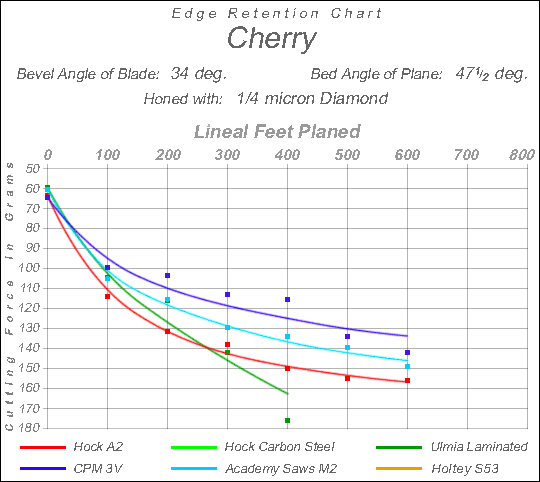To test how long a blade would hold a usably sharp edge, each one was honed using 1/4 micron diamond paste. It was examined under the microscope to check for defects and its initial sharpness was measured. Then it was used to plane the edge of an 8/4 piece of cherry, making shavings about .001” thick. After each 100 lineal feet the blade edge was examined under the microscope to check for defects and its sharpness was measured. Then the blade was used to plane another 100 lineal feet. This process continued until the blade was too dull to use or my patience ran out.
At each stage of testing the entire edge was examined under the microscope to check for defects. If damage was present, the worst chip or deformation was photographed. If only abrasion had occurred, an area of typical abrasion was photographed.
A valid criticism of this method is that the real test of a blade is the quality of the surface it produces on wood rather than the condition of the blade edge itself. Since I haven’t found a good quantitative method for evaluating wood surfaces or even a good way to photograph them, I’m making the assumption that a sharper edge will produce a better surface. My subjective judgment of the planed surfaces seems to confirm this.
Edge Retention Charts
Edge retention is the easiest property to measure and present in a concise form. The chart below shows the results for blades tested by planing cherry using a plane with a 47½º bed. The falling lines reflect loss of sharpness as measured by the amount of force it takes for the blade to cut through a loop of thread. Each of the square data points represents the average of at least seven loops cut. The curved shape of the lines is based on my observation that the typical pattern of the results shows a more rapid loss of sharpness early in a test, followed by gradually slower loss of sharpness as the test proceeds. After each test I try to find a curve of this shape that passes as close as possible to the data points.
Since the cutting force numbers in grams are difficult to relate to the ordinary descriptions of sharpness used by woodworkers, I’ve put together a chart to help make them easier to understand. My personal limit when using a blade for ordinary smooth planing is about 150 grams.

The lines on the chart reflect the overall sharpness of the edge, not specific defects such as chips. In most cases the loop of thread will not fall into such a defect. This means that blades that appear equally sharp on the chart may in fact differ in performance due to defects. At a bevel angle of 34º chipping has not been a problem when planing cherry.
Since some of the blades show no chipping or deformation at 34º, I’ve begun testing them at more acute angles. The results of these tests can be seen on the page Bevel Angles.